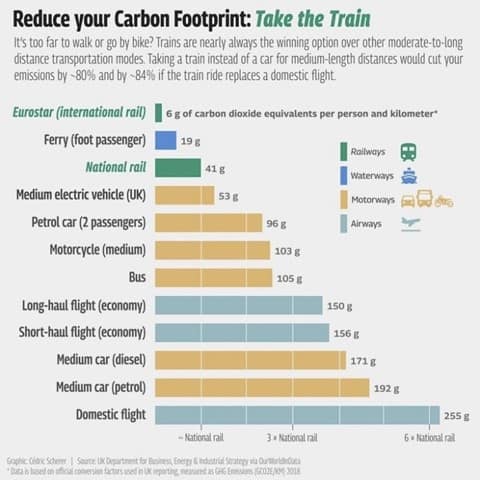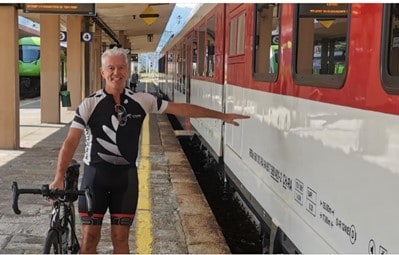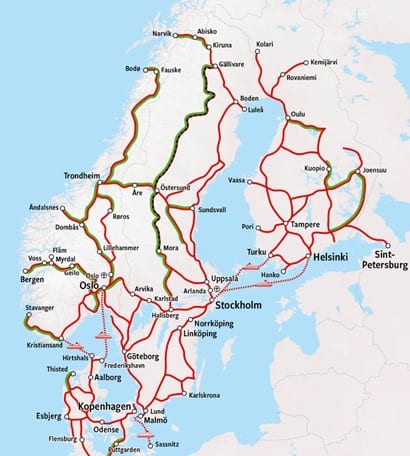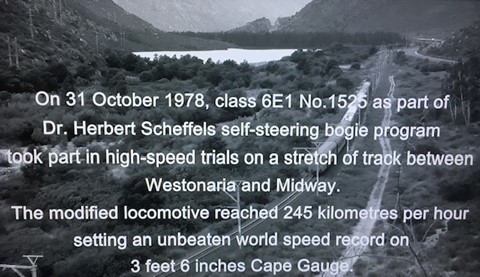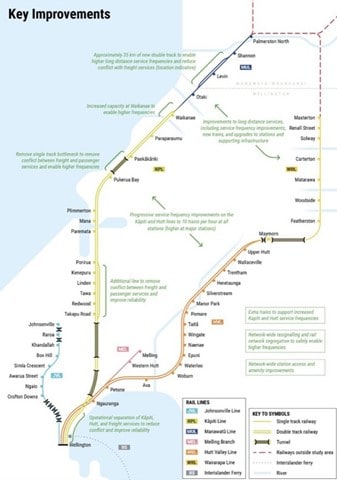By Michael Nicholson, 8 August 2022
Rail Transport – Green Credentials
Rail transport is a very energy efficient form of transport with excellent green credentials. Steel-wheels upon steel-rails provides low friction and therefore low rolling resistance, resulting in much reduced energy usage compared to air and road transport. KiwiRail is said to cause 70% less emissions than road transport, even with the majority of their trains operated using diesel locomotives. Rail transport becomes zero emissions when electrified. In addition, modern electric locomotives and passenger rolling stock can recoup energy via regenerative braking technology, recapturing between 10-45% of the original energy used. This recouped energy can be used by other trains or feed back into the national power grid.
Passenger Rail – Low Emissions Travel
International studies show that modern passenger rail is by far the least polluting form of surface transport there is. Throughout the world there is a growing recognition of the role which modern passenger rail can play in drastically reducing emissions.
Long distance passenger rail networks are being improved and expanded, this includes the revival of night trains with new routes and investment in new trains.
New Zealand is unlikely to need the super-fast bullet trains seen in Japan, China, Europe, Egypt and now the United States. However, fast rail is achievable, we could certainly increase speeds and improve travel times.
Incremental investment and improvements could revive New Zealand’s once extensive passenger rail network, this would reduce emissions in the transport sector and better connect communities.
Night trains are a realistic alternative to flying on longer journeys. Night trains are all about convenient departure and arrival times, city-centre to city-centre. Modern night train travel is handy and a good use of time while travelling – jump into a comfortable bed and sleep the miles away.
What is the relevance to Kāpiti?
First European settlement in Kāpiti and Horowhenua was mostly limited around stagecoach staging points. These were required at set intervals as horses had a limited range before needing to be watered, fed and rested. Stagecoach travellers and drivers also required rest and provisioning.
In 1881 the privately owned Wellington & Manawatū Railway Company opened between Wellington and Longburn. This provided better transport links through the Kāpiti area. Trains improved access to other regions / cities and markets with the relative speed and comfort these new train services provided. Settlements and commerce grew more quickly around railway station locations. The Wellington & Manawatū Railway Company was nationalised in 1908 and the line through Kāpiti and Horowhenua became the lower North Island section of the North Island Main Truck line to Auckland, thus further improving access to the rest of New Zealand – communities continued to grow and regional populations have expanded to this day.
Gradually an electric suburban rail network has been extended up the coast, first to Paekākāriki, then Paraparaumu and most recently to Waikanae. Services have been improved in recent years through investment in new trains, more frequent operations and better reliability – this has led to the high use of trains by Kāpiti commuters.
There have long been proposals to extend regular services to the growing town of Ōtaki. Ideally, double tracking from Waikanae to Ōtaki would have taken place at the same time as building the expressway extension. Currently proposals for extending electric commuter rail services have stalled.

Ōtaki could be better connected with Wellington through an upgraded Capital Connection service. Our neighbouring regional council, Horizons, and Greater Wellington Regional Council have developed a business case for modern and more regular, including weekends, Capital Connection services. The trains would be powered by very low emission hybrid electric system where batteries took over when the overhead power cables stopped. This proposal was supported by Manawatū-Whanganui’s seven mayors, as well as the eight mayors of the Wellington region. The proposal sought funding support through the 2022 budget, however, funding was turned down – even though the business case for new trains and other passenger rail improvements has a very good cost benefit rating and many other tangible advantages, such as: emissions reduction, reducing road traffic congestion and better connecting lower North Island communities. It can only be assumed that this worthwhile passenger rail project will eventually be funded at a future date.
In terms of longer distance travel, Kāpiti was once linked through Palmerston North to Whanganui and through to New Plymouth on the west coast and Napier, Gisborne and the Northern Wairarapa to Masterton to the east. It was also linked to stations through the central North Island to Hamilton and Auckland with both a night and day trains.
Due to lack of investment, aging carriages (some over 75 years old when retired) all services slowly ceased until there was just the irregular and expensive tourism oriented Northern Explorer and even that service ceased in December last year. After public outcry a group of concerned citizens formed the Save Our Trains campaign. It has now been announced that these trains will resume again in September this year.
The Northern Explorer will remain an irregular, even more unaffordable service for kiwi families, with an adult fare from Auckland to Kāpiti being $219. Still, due to the efforts of the Save Our Trains campaign, at least there now remains a passenger rail option departing Paraparaumu for destinations north.
Bikes, Scooters and Trains
Bikes, scooters and trains go hand-in-hand and provide an excellent way to extend the reach of both train travel and biking.
Improvements are needed, such as the ability for trains to carry more bikes and for bikes to be available for casual hire at stations, this could be in the form of pre booked hire bikes / scooters from stations, via an app system to guarantee availability. Due to their proximity to town centres, Palmerston North, Masterton and Woodside (Greytown) station users could benefit greatly from more bike stowage space on trains and also a casual bike / scooter hire system.
World of Trains Outside of New Zealand
So, if we were in Germany, France or perhaps similar sized countries like Norway, Switzerland or Finland, what would our rail network look like?
Not that long ago, like countries mentioned above, New Zealand had a comprehensive and joined-up national passenger rail network. This network had good national coverage and was well connected to other modes such as ferry services and feeder buses, this extended reach and formed a total public transport option.
Good examples of how organised passenger rail with feeder buses linking smaller communities can work well is found in the Australian States of New South Wales (TrainLink) and also Victoria (VLine).
Our narrower ‘cape-gauge’ railway puts some limit on speed; however, when it comes to improving travel times focusing on average speed is more important than the top speed. The average speed of trains can be improved by progressively easing curves, improving signalling, better maintaining tracks, designing trains to facilitate faster boarding and de-training – a higher average speed will improve overall travel times.
An option could be to adopt tilt train technology, both Australia and Japan operate tilt trains on the same gauge track as New Zealand and can travel around curves 10 % faster, these trains have better acceleration and deceleration qualities and where possible can reach top speeds of up to 160 km/h. With a suitable programme of staged investment, we could have rapid rail linking Wellington and Palmerston North, with potentially a couple of stops in Kāpiti.
It’s worth noting that South Africa also uses the same track gauge as New Zealand (hence cape-gauge). Speed trials were undertaken in South Africa in 1978 and a top speed of 245 km/h was attained. With investment and planning our railway can achieve faster operation.
Night Trains
Modern night trains are a realistic alternative to very polluting air travel, over longer journeys. Kāpiti to Hamilton and Auckland is identified as an ideal distance (and travel time) to conveniently link these centres.
Not so long-ago Kāpiti travellers had the choice of two quality night trains in each direction linking Kāpiti and Auckland (and points in-between), an earlier train in both directions and also a later departure in each direction. These trains had sleeper compartments and good catering; one train also had cheaper seats for budget travellers. Service was later reduced to one train each night in each direction, providing only seats and a limited catering service, although not as attractive this train still provided a handy and well used service linking Kāpiti. Unfortunately lack of investment and political will forced closure of the last remaining night train in 2004, this due to carriages being over 75 years old and deemed unfit for continued operation.
Modern night trains would now be an ideal way to link Kāpiti with the central north island for recreation and further afield to Hamilton, Auckland and possibly Northland. Going north the train would pass through Kāpiti late in the evening, arriving for breakfast in Auckland, the train could then possibly continue through to Whangarei for a late morning arrival. Southbound carbon conscious travellers from the north would arrive for breakfast in Kāpiti, such a service would be civilised and really handy for travel needs, it would also support truly green tourism in Kāpiti. Three accommodation options could capture passenger needs and traveller expectations:
- Sleeper compartments – private hotel room style, very comfortable, most expensive.
- Lay flat seats – dorm style at night with lay flat beds, not so expensive
- Sit up seating – for those on a budget or who are not travelling longer distances – cheapest budget option.
- Ideally, there would be plenty of space to carry bikes.
Positive Developments – Lower North Island Rail Infrastructure Investment Approved
Greater Wellington Regional Council has recently endorsed the Wellington Strategic Rail Plan, this is a 30-year plan to improve Wellington regional railway infrastructure. It will allow for the improved passenger rail capacity on all lines and for growth in rail freight operations. Whilst 30 years sounds like a long period, tangible service improvements will occur within this period as investment work progresses.
Peak time frequency will improve to:
- Four trains on all lines by 2025, train every 15 minutes.
- Longer distance train frequency to Palmerston North and Masterton will improve by 2028.
- Six trains on all lines by 2032, train every 10 minutes.
- Inter-peak services will increase to four services per hour, train every 15 minutes.
- Ten trains per hour (every 6 minutes) on the Kāpiti line mid 2030’s, Hutt line early 2040’s.
Network reliability and robustness will improve and capacity will progressively increase as infrastructure is improved.
Some key infrastructure developments include:
- Double tracking the bottleneck single line section of track between Pukerua Bay and Paekākāriki.
- 35km of new double track in the Levin area, to facilitate increased frequency of long-distance passenger rail and freight operations.
- Improved Waikanae track layout to allow for increased frequency.
- Building a third main line between Takapu Road station and Porirua.
- Separating Kāpiti, Hutt and freight lines out of Wellington to reduce conflict and improve reliability.
- Signalling upgrades to allow for bi-directional operation of lines.
- Station upgrades
Possibility for Extending Electrification – Zero Emissions Rail
Studies commissioned by Government around options for extending railway electrification were recently made public.
Options which might benefit the Wellington Region include:
- Waikanae to Palmerston North (AC system). This would also link into the existing electrified railway to Hamilton. Requires dual voltage locomotives and passenger equipment (common in Europe and South Africa) to operate south of Waikanae, this operates a DC system. Electrification would benefit both passenger rail and rail freight with a faster, more efficient and zero emissions operation over this route.
- Upper Hutt to Masterton. (AC or/ a much cheaper option for continuing the DC system north of Upper Hutt). This would allow for higher frequency passenger and freight train operations through the 8.93km Remutaka tunnel. Currently trains are limited by diesel fume restrictions which requires time for toxic fumes to vent between train services, thus limiting the number of trains which can use this valuable asset. Passenger and freight trains between Wellington and Masterton would be faster, more efficient, more frequent and zero emissions.
Into the Future – Modern Passenger Rail Network for New Zealand
Long distance passenger rail is a national issue. In order to develop and expand the national network there needs to be central Government policy, leadership and investment.
It might be appropriate to form some type of central government agency to develop, expand and operate passenger rail separately from KiwiRail, something along the lines of Amtrak / VIA Rail / PRASA / Great British Railways. The Green Party have a very good passenger rail policy which would be a useful starting point for government in developing a plan for incremental rebuilding of our national network.
Passenger rail can make New Zealand a better place to live. Passenger rail brings many advantages, such as: connecting communities / regions and cities, opening up regional work / education / recreation and tourism opportunities, saving lives through reducing road fatalities, providing quality transport options and choice, avoiding and reducing road traffic congestion, reducing emissions.
Extending long distance passenger rail to Napier, Gisborne, Northern Wairarapa (to Masterton), Whanganui, New Plymouth, Increased service to Hamilton and Auckland (including night trains) will also provide increased travel choice on the Palmerston North to Wellington corridor.
Integration with other modes is important and will extend the reach of passenger rail, thus providing a total public transport alternative to driving or in some cases flying (i.e. night trains).
Passenger rail is basic public infrastructure which should not be politicised, there needs to be acceptance of the greater good aspects which passenger rail brings – New Zealand can have it all, roads, air travel (when appropriate) and well-functioning modern passenger rail.
